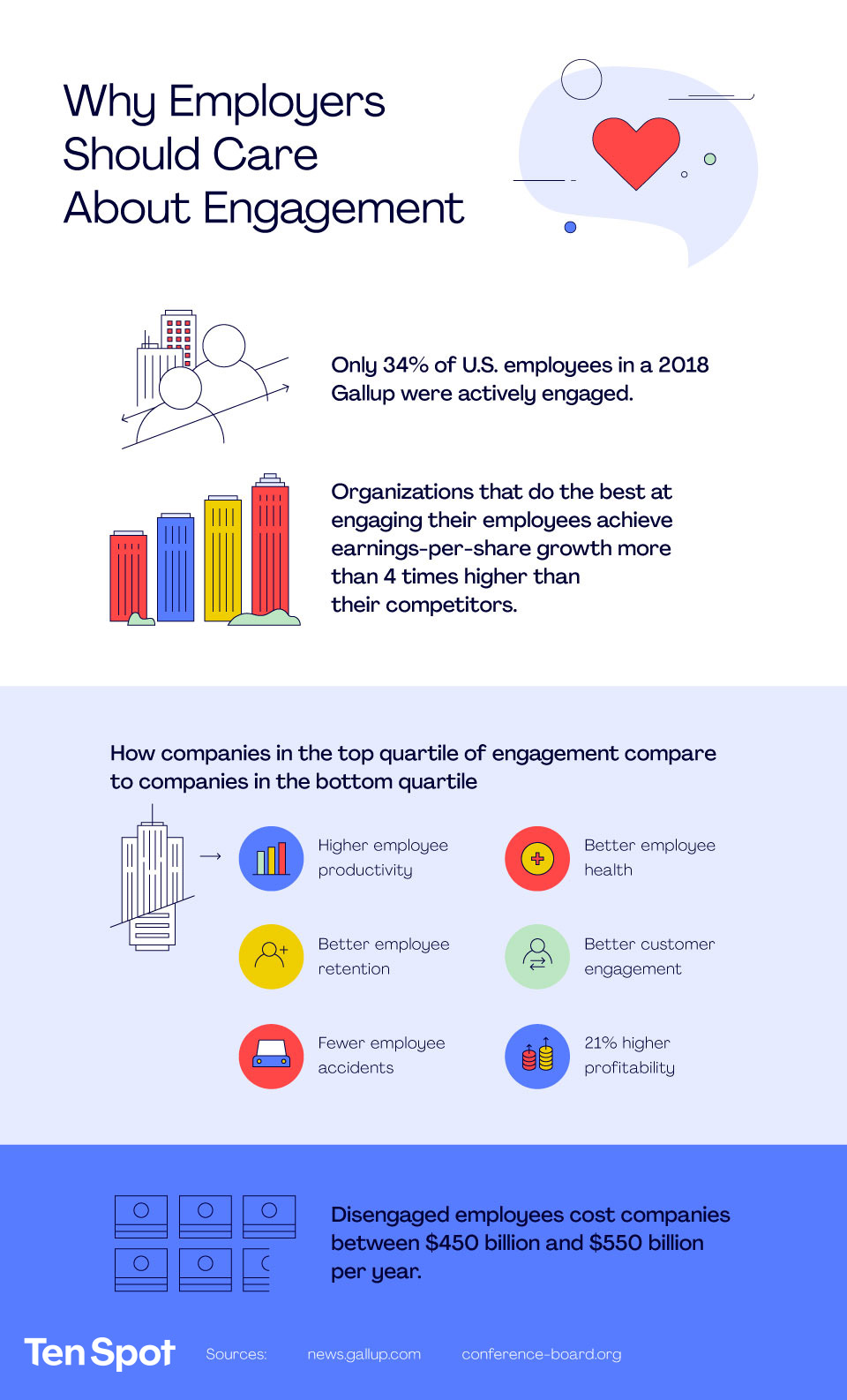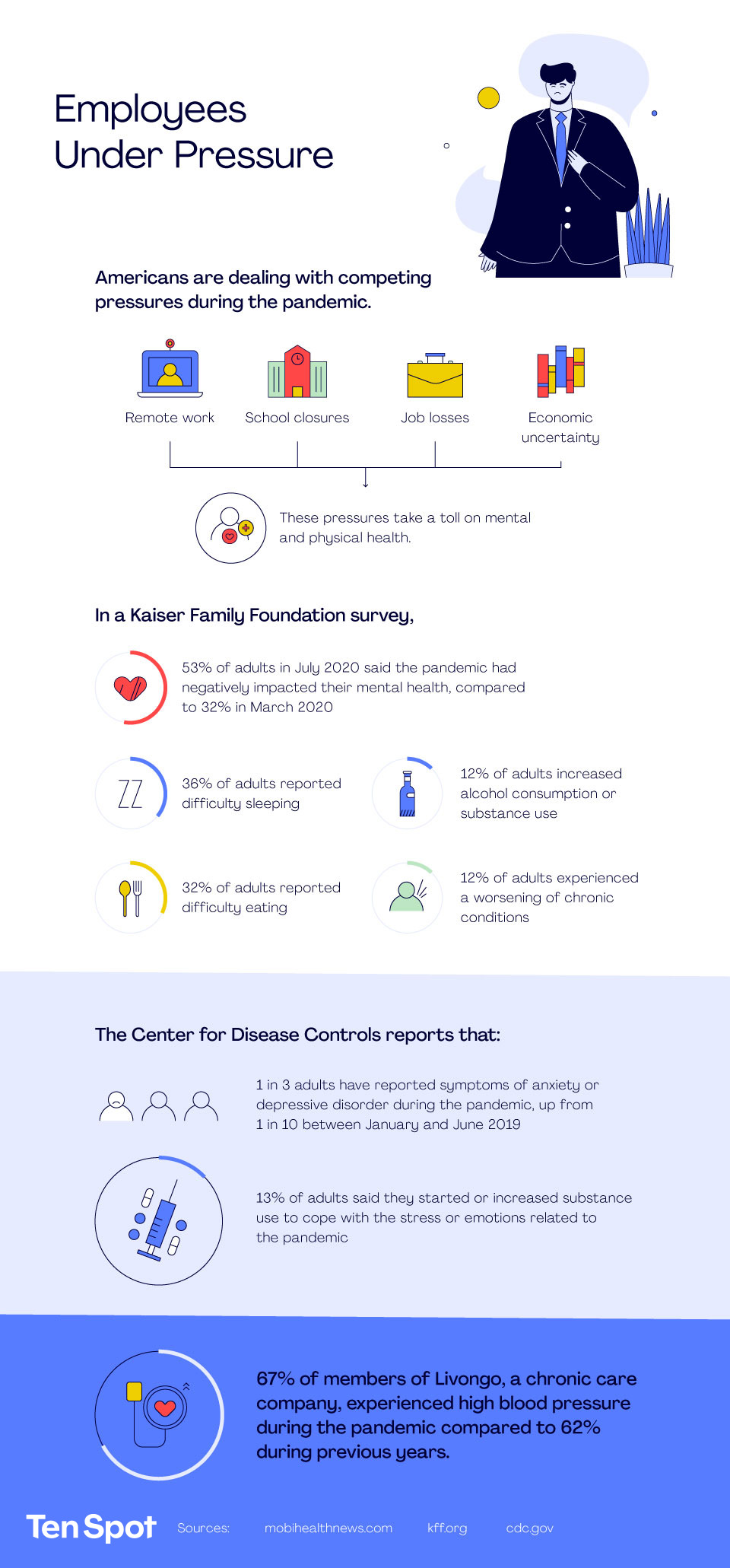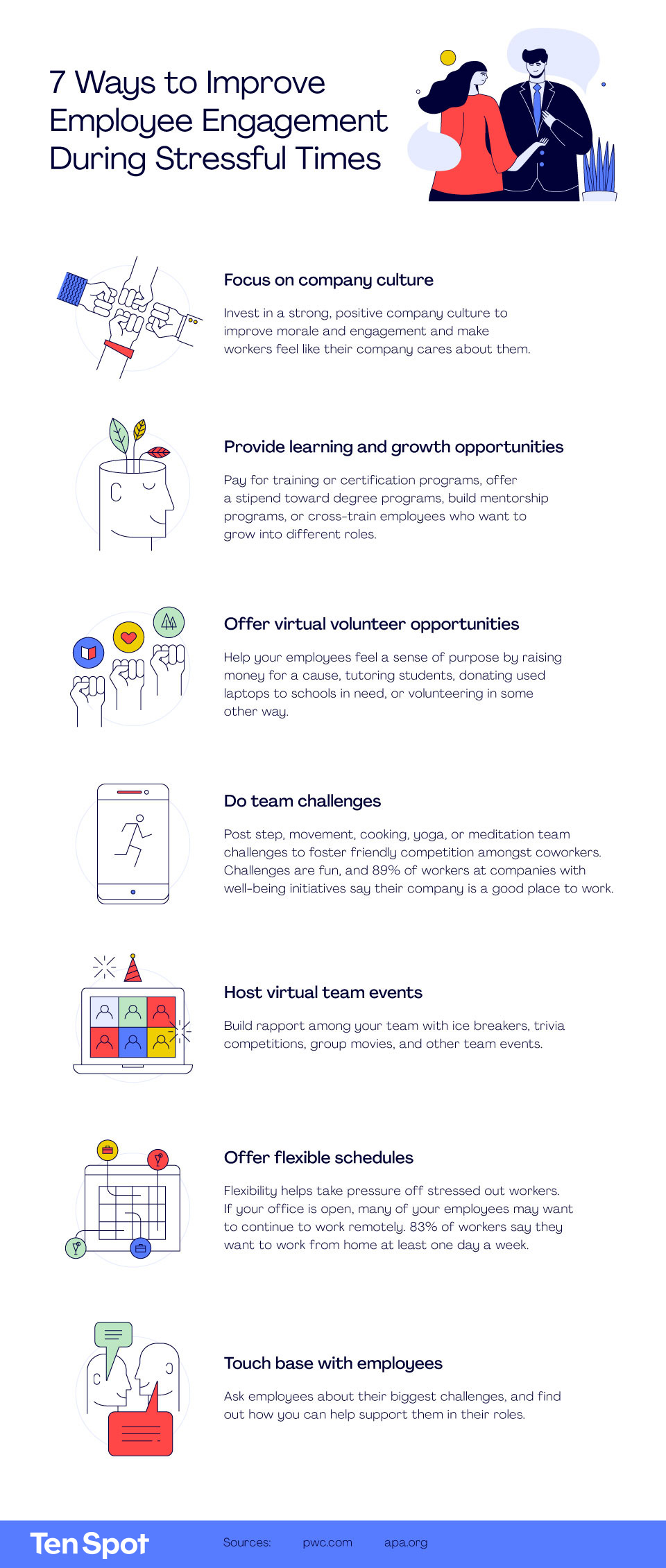Engaged employees are productive employees, but in 2020, the COVID-19 pandemic has walloped the American workforce. Because of state lockdown orders, employers across the country sent workers home to work remotely. For working parents, many are helping their kids with distance learning while facing unprecedented stress and economic uncertainty. How can organizations guide their employees through these challenging times while keeping employee engagement high?
This article will answer important questions, such as what is employee engagement and why should employers care about engagement? We’ll look at some of the unique challenges the pandemic has dropped onto the American workforce, and we’ll explain how to improve employee engagement even when the world feels upside down.
What Does Employee Engagement Mean?
Before you can improve your company’s employee engagement, it helps to understand what engagement means. In a 2018 survey of employee engagement, Gallup divided workers into three levels of engagement.
Engaged
Workers “who are involved in, enthusiastic about, and committed to their work and workplace”
Not engaged
Workers who “may be generally satisfied but are not cognitively and emotionally connected to their work and workplace”
Actively disengaged
Workers “who have miserable work experiences”
According to Gallup’s survey, a record-setting 34 percent of workers described themselves as engaged at work. Of course, this number is hard to celebrate because it means a whopping 66 percent of workers were either not engaged or actively disengaged. And researchers did this survey in 2018, long before COVID-19 closed more than 160,000 businesses across the United States and sent 66 percent of the country’s workforce home to work remotely.
Why Is Employee Engagement Important?
Does it matter whether your employees are happy at their jobs? According to the Gallup poll, the overwhelming answer is yes. Engaged employees work harder, put in longer hours, and stick with a company longer, offering increased expertise and efficiency. Engaged employees are more likely to go the extra mile for customers, drive teams to accomplish more, and mentor and train new employees.
How does employee engagement impact a company’s bottom line? Gallup’s employee engagement survey suggests that companies in the top quartile of employee engagement enjoy 21 percent higher profitability than companies in the bottom quartile of employee engagement.
On the other hand, disengaged employees work less, suffer from more workplace accidents, and are more likely to leave. No wonder disengaged employees cost U.S. companies between $450 billion and $550 billion a year, according to a study by The Engagement Institute.

How the COVID-19 Pandemic Has Affected Employee Engagement
2020 has been an interesting year. For most workers, the COVID-19 pandemic has caused significant career and personal upheaval, which impacts their work engagement.
A forced shift to remote work
As governors and mayors announced shutdowns across the country in March and April, millions of workers found themselves trying to work at the breakfast nook, figuring out Zoom calls, and realizing their internet connection was inadequate for streaming work webinars.
According to Gallup, 62 percent of employees worked from home during the early months of the crisis. While remote work can offer some nice perks – pajama work uniforms! – it presents challenges. Workers may feel isolated from their coworkers and disconnected from the company’s mission. Working from home can also come with new distractions, making it difficult for workers to stay focused.
Nowhere for the kids to go
Just as offices sent workers home during the early part of 2020, schools quickly followed. Forty-eight states, four U.S. territories, and the District of Columbia closed their schools or recommended school closures. With limited childcare options, parents needed to put in a full day of work while caring for kiddos.
As of late 2020, schools remain closed in hard-hit areas. Other school districts offer hybrid options, allowing kids to come in part-time and leaving parents to care for them when schools are closed. Many working parents are acting as a full-time parent, teacher, and employee at the same time.
Economic uncertainty
According to a September Bureau of Labor Statistics report, more than 19 million Americans reported they were unable to work at some point in the previous month. Even workers who have their jobs may be making do with pay cuts or worried about future furloughs or layoffs. If your company is still going strong, that doesn’t mean your employees have nothing to fret about. Their spouses or partners may have recently lost jobs. In a Pew Social Trends survey, 25 percent of respondents said someone in their household got laid off due to the pandemic.
Stress Is the big pandemic winner
Unsurprisingly, all these unhappy pandemic trends lead to the same place. Your employees are stressed! According to a tracking poll conducted by the non-profit Kaiser Family Foundation in July, more than half of adults in the U.S. said the COVID-19 pandemic had negatively impacted their mental health. Compare this to only 23 percent of adults who answered the same way in March when many people thought the pandemic would blow over in a matter of weeks.
Your workers are probably feeling isolated. They may be juggling parenting and teaching responsibilities. They may have a household member who lost a job. All these factors have created a potent stress cocktail. Anxiety and uncertainty will impact your employees’ work and your bottom line unless you prioritize improving your company’s employee engagement.

How to Improve Employee Engagement
Your company can work to improve employee engagement in various ways. Not every employee engagement strategy requires a big budget. Sometimes the most effective methods are the least expensive, which is good news for companies struggling with profit losses due to the pandemic.
Focus on company culture
In the Harvard Business Review, Frances Frei and Anne Morriss write that “Culture guides discretionary behavior and picks up where the employee handbook leaves off.” What is the culture of your company? Do workers have the autonomy to craft their roles? Do employees at every level encourage and foster new ideas? Do managers take on mentorship roles? Strong and positive company culture improves morale and engagement and makes workers feel like their company cares about them. As marketing guru Neil Patel says, “Culture sustains employee enthusiasm.”
Provide learning and growth opportunities
A great way to keep up morale and encourage your employees to stick with you through this challenging stretch is to offer learning and growth opportunities. “Creating a culture that fosters continuous development does more than help workers build the skills they need to do their jobs,” writes Tamara Lytle for the Society of Human Resource Management blog. “It also communicates that the organization values its employees and believes in their potential.”
Pay for training or certification programs or offer a certain amount toward degree programs. If money is tight at your company, build mentorship or cross-training programs for employees who want to grow into different roles.
Offer virtual volunteer opportunities
Volunteering makes employees feel good about themselves, helps them connect to their coworkers in new ways, and gives them an important purpose through work. Think about what you and your team can do to make a difference in your community. Could your team raise money for a great cause through a virtual race or walk-a-thon or tutor kids online who need help catching up at school? Could your company donate used laptops to children who need them for remote learning? Opportunities abound to make a difference in your community. Ask your employees for ideas on how to volunteer, and consider letting them vote for a cause to support.
Do team challenges
Working on a remote team can be isolating, but you can bring your team together with a team challenge. One popular option is to create a fitness leaderboard and encourage team members to compete for step or movement goals. Wellness programs offer many benefits. Not only are workers healthier and happier, but 89 percent of workers at companies with well-being initiatives say their company is a good place to work.
Don’t stop there. Put together cooking challenges, meditation challenges, a yoga challenge, and more. Get creative and ask your team for group challenge ideas.
Host virtual team events
Yes, the virtual cocktail hour has been done to death, but your team members can benefit from seeing each other outside Zoom meetings or work email chains. Promote camaraderie through virtual events. How about a team trivia night or movie night? Even pulling your team together for ice breakers is a great way to build rapport when workers can’t be in the office.
Offer flexible schedules
As more workers across the country head back to the office, they won’t forget how nice it was to work remotely. According to a survey by the global network of firms PwC, 83 percent of workers want to work from home at least one day a week.
Talk to your workers and figure out what type of schedule would help them be most productive. Be willing to offer flexibility. An employee with a long commute may appreciate working from home, whereas a working parent may benefit from coming to the office a little later than normal to drop children off at school.
Touch base with your employees
Sometimes the simple act of sitting down for a face-to-face check-in (even if it’s virtual) goes a long way toward building goodwill between you and your employees. Check in to see how each employee is doing. Ask about their biggest challenges, and find out how you can help support them in their roles. Not only will you gain a better understanding of each employee, but you’ll also get valuable feedback that can help you improve your team’s productivity and efficiency.
How to Measure Employee Engagement
Before you implement employee engagement programs at your company, it helps to know your current engagement level. How can you tell if your strategies work if you don’t establish engagement metrics and figure out your starting point? You can measure employee engagement in numerous ways. For instance, track how many calls a customer service rep takes, how many deals your sales members close, or how long each employee logs into your team management software.
And one of the best ways to measure employee engagement is to ask your employees how they’re feeling. Consider sending out anonymous surveys asking your employees how they feel about their company and their jobs. Ask for specific feedback, and welcome suggestions to help you develop engagement improvement strategies. Your employees will appreciate that you care enough to ask their opinions, especially if they see you implementing their suggestions.
Conclusion
By seeking to understand and improve your company’s engagement levels, you can boost morale in this most trying of years!
This blog post was written by Jessica Bennett from Ten Spot on their website here. Read more blog posts on Employee Engagement here.





